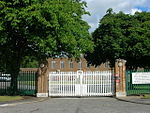RAF Driffield
1918 establishments in the United KingdomBuildings and structures in the East Riding of YorkshireDriffieldMilitary units and formations established in 1918Royal Air Force stations in Yorkshire ... and 4 more
Royal Air Force stations of World War II in the United KingdomUse British English from October 2013World War I airfieldsWorld War I sites in England
Royal Air Force Driffield or RAF Driffield is a former Royal Air Force station in the East Riding of Yorkshire, in England. It lies about 2 miles (3 km) south-west of Driffield and 11 miles (18 km) north-west of Beverley. It is now operated by the Defence Infrastructure Organisation, as the Driffield Training Area.
Excerpt from the Wikipedia article RAF Driffield (License: CC BY-SA 3.0, Authors).RAF Driffield
Ramsden Close,
Geographical coordinates (GPS) Address Nearby Places Show on map
Geographical coordinates (GPS)
| Latitude | Longitude |
|---|---|
| N 53.994722222222 ° | E -0.48638888888889 ° |
Address
Driffield Training Area
Ramsden Close
YO25 9DJ
England, United Kingdom
Open on Google Maps










